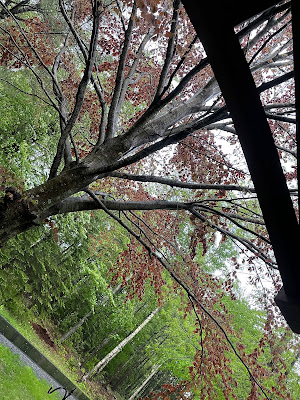John and I were sitting on the front porch, watching the thunderstorms roll in and out, and I had this moment. I realized that the beech that I have loved from the first time I saw the house is not just any beech. It's a Copper Beech. How could I have missed that?
To be fair, a Copper Beech looks different in the fall than in the spring. It's more purple/green, less copper. But you can see as it's leafing out in the image to the left that it is indeed copper. Another favorite tree, and she was right here waiting for us. Yay.
So on to the local hike from the previous post.
In the last post, I mentioned the drifts of yellow violets.
But there's more. These tiny white and purple flowers are also in drifts. . .four petaled tiny wonders that remind me of forget-me-nots.
Beautiful tiny flowers. You can tell how small they are compared to the oak leaf on the floor next to them.
Enter the edibles. These strawberries form colonies along other areas on the path. My experience with wild strawberries is that they are lovely, but not really very tasty. I can't wait to try these to see if they break that rule.
 |
| Closeup of strawberry flowers |
I was shocked to see these guys. How could I have missed them in the fall? These are lowbush blueberries (Vaccinium angustifolium). Maine is famous for these. Like their relatives, the American cranberry, they grow quite low to the ground. Native populations are harvested by locals using hand-held wooden tools that look like a small box with a handle and combs on the front. The blueberries can be bought at various little local grocery stores. And they are delicious, with decidedly intense flavor. The best blueberry ever.
 |
| Lowbush blueberry colony |
The wet fecund nature of these environs is not for everyone. I love the density, variety and richness of life here. And I love the water falling from the sky. But it comes with some decided challenges.
 |
| Things grow everywhere |
 |
| A clearing along the way |







No comments:
Post a Comment
Leave comments here!